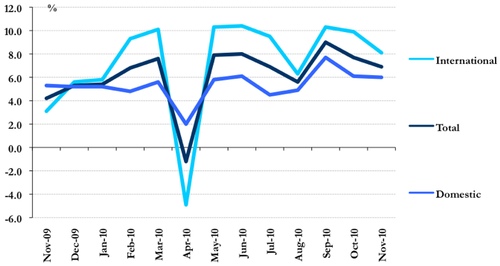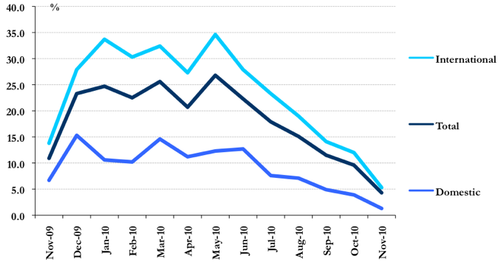New record for global airport traffic expected in 2010: ACI World
ACI World stated that Nov-2010 traffic data indicates that 2010 will set a new record for global airport industry traffic with total passenger growth of near 7%. ACI also noted that freight growth has been "exceptional" in 2010 despite a marked slowdown in 2H2010. Growth of close to 18% is expected to "more than compensate" from the 8% slump in 2009.
Traffic growth of 6.9% in Nov-2010
In Nov-2010, total passenger traffic increased by 6.9% year-on-year with international traffic up by 8.1% and domestic by 6%. For the 11 months to Nov-2011, passenger traffic increased by 6.5%.
ACI total passenger number growth: Nov-2009 to Nov-2010
Marked regional difference for passenger growth
ACI noted that there marked regional difference for passenger growth. While the Asia Pacific, Middle East and Latin America-Caribbean regions surged well beyond pre-crisis passenger volumes, Europe and North America lag behind previous peak performance.
However, ACI noted that Europe appears to be on track to becoming the largest traffic region in 2010 for the first time ever, moving ahead of the North America market. ACI added that it "remains to be seen how significantly the harsh winter weather will affect December traffic results".
ACI pax growth by region in Nov-2010 and YTD Nov-2010
Only 15% of airports witness passenger reduction in Nov-2010
Specifically, Russia, India, Egypt, Brazil, South Korea and the UAE contributed most significantly to the increase in passengers worldwide in Nov-2010. Individual airports outside of these countries that had a favourable impact on passenger numbers worldwide were Shanghai Hongqiao (+24.5%), Barcelona (+15%), Boston (+13%), Amsterdam (+11%), Munich (+11%), Kuala Lumpur (+10.5%), New York/ LGA (+10%), Istanbul Ataturk (+12.5%), Manila (+16.5%).
The worldwide growth average was slightly dampened by results reported from Athens (-9.5%), Mexico City (-9.5%), London Stansted (-7.5%), and Tokyo Narita (-6). Overall, however, only 15% of airports in the sample registered a reduction in passengers.
Domestic traffic was strong in China, India, Brazil, Turkey and the US. For international traffic results, Mexico City (-22%) and Tokyo Narita (-7.5%) suffered the largest declines, while Muscat (29.5%), Moscow Sheremetyevo (+24%), Cairo (+23%), Barcelona (+20%), Incheon (+20%), Dubai (+16%) gained significant international traffic.
In Asia Pacific, the largest market China has slowed to single digit growth, which is the slowest growth rate in the region since Jul-2009. Europe benefited from very robust growth in Russia and Turkey. North America results are pushed by domestic carrier competition especially on the East Coast, whereas Latin America-Caribbean results were dragged down by traffic drops in Mexico where the security situation weighs on demand for inbound travel.
Freight growth slowing after rapid rebound in 1H2010
Freight traffic growth, meanwhile, is still slowing relative to its rapid rebound in 1H2010. Freight increased 4.3% year-on-year in Nov-2010, marking the slowest month of growth since Oct-2009, although growth compares to an 11% increase in Nov-2009. Year to date, global freight growth is 18.2%.
ACI total cargo volume growth: Nov-2009 to Nov-2010
ACI, meanwhile, noted that the divergence among the regions in freight growth is less pronounced than in the passenger sector, as all regions enjoyed double digit growth earlier in 2010.
APPENDIX: ACI TRAFFIC TABLES
ACI World traffic results: Nov-2009 vs Nov-2010 growth levels
|
Nov-2010 |
11 months to Nov-2010 |
12 months to Nov-2010 |
|
|---|---|---|---|
|
International passenger |
8.1% |
7.7% |
7.5% |
|
Domestic passenger |
6.0% |
5.5% |
5.5% |
|
Total passenger |
6.9% |
6.5% |
6.4% |
|
International freight |
5.3% |
23.4% |
23.8% |
|
Domestic freight |
1.3% |
8.6% |
9.2% |
|
Total freight |
4.3% |
18.2% |
18.6% |
ACI world traffic results by region: Nov-2009 vs Nov-2010 growth levels
|
Nov-2010 |
|
|---|---|
|
Total passenger traffic |
6.9% |
|
World domestic |
6.0% |
|
World international |
8.1% |
|
10.3% |
|
|
8.2% |
|
|
6.9% |
|
|
Latin America and the Caribbean |
5.1% |
|
12.9% |
|
|
5.2% |
|
|
Total freight |
4.3% |
|
World domestic |
1.3% |
|
World international |
5.3% |
|
-2.2% |
|
|
3.4% |
|
|
8.0% |
|
|
Latin America and the Caribbean |
2.0% |
|
1.3% |
|
|
+3.8% |


